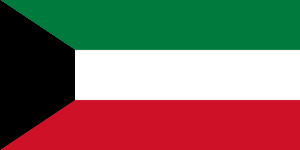
| Colors | HEX Code | RGB | CMYK |
|---|---|---|---|
| Black | #000000 | 0, 0, 0 | 0, 0, 0, 100 |
| Green | #007A3D | 0, 122, 61 | 100, 0, 50, 52 |
| White | #FFFFFF | 255, 255, 255 | 0, 0, 0, 0 |
| Red | #CE1126 | 206, 17, 38 | 0, 92, 82, 19 |
The Kuwaiti flag has three horizontal stripes colored green, white, and red, from top to bottom. On the hoist side, there is a black trapezoid.
Meaning of the Kuwaiti flag
The colors of the Kuwaiti flag are the Pan-Arab colors. They are inspired by Saffi-El Din Al Hilli’s poetry, who lived in the 14th century. The red stripe symbolizes the blood of Kuwait’s enemies, the white stripe represents purity and honesty, and the green stripe symbolizes the fertility of Kuwait’s land and its Islamic faith. The black trapezoid represents the defeat of the enemy.
History of the Kuwaiti flag
Kuwait was a Sheikdom under Ottoman protection, having an independent authority. In 1899, Britain and Kuwait signed a treaty that prevented Kuwait from using any of its territories without the consent of the British, while the British provided security and defended the country. Britain had strengthened its ties with Kuwait which was ruled by “Al Subah ” dynasty. The country had to use a distinct flag so that its vessels would not be targeted by the British army. The first flag of Kuwait under British rule was red, with a crescent and a star at the top left corner. Then the crescent and stars were replaced with the name of the country and al Shahadah written in Arabic. Kuwait then became a British protectorate and continued to use the same flag until it gained its independence in 1961. The flag of independence was inspired by the Pan-Arab colors that gained popularity during the Arab Revolt before WWI.